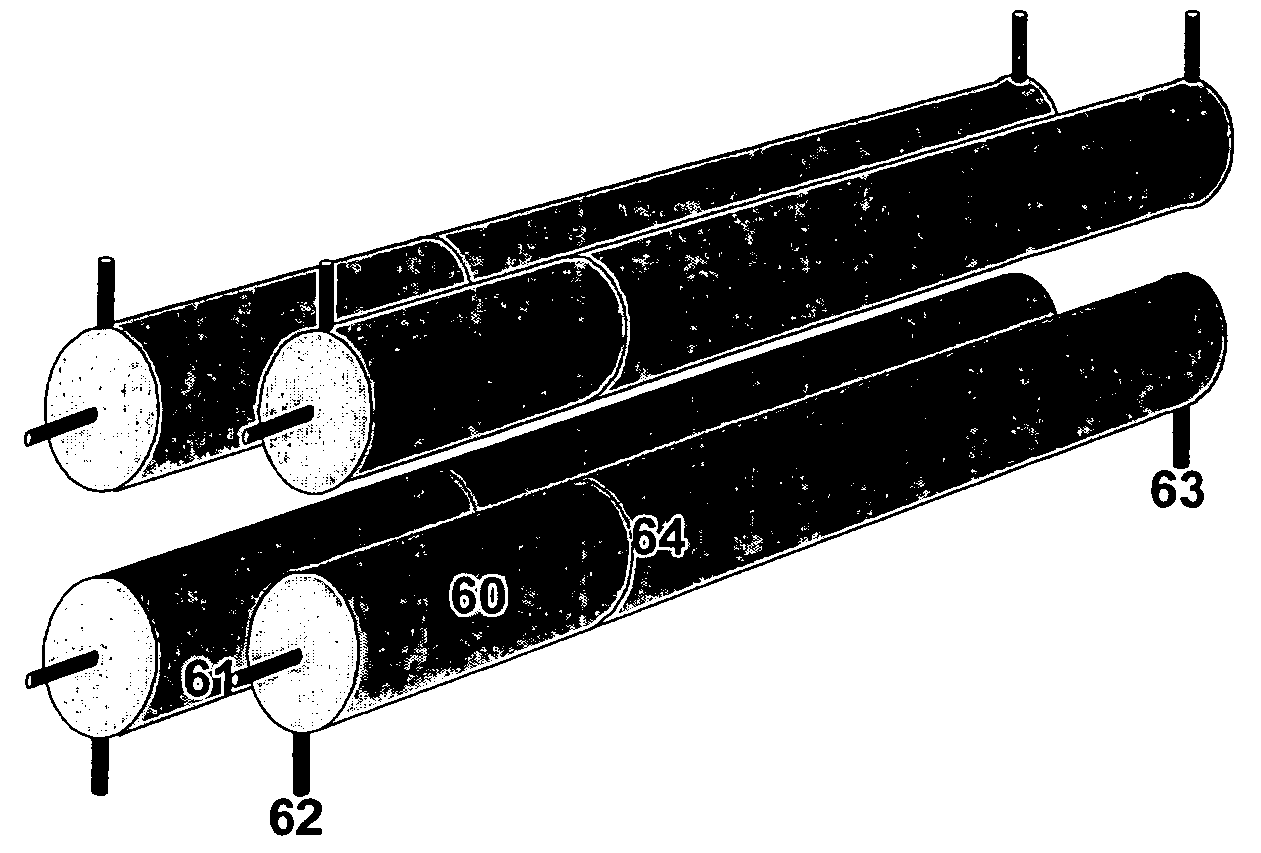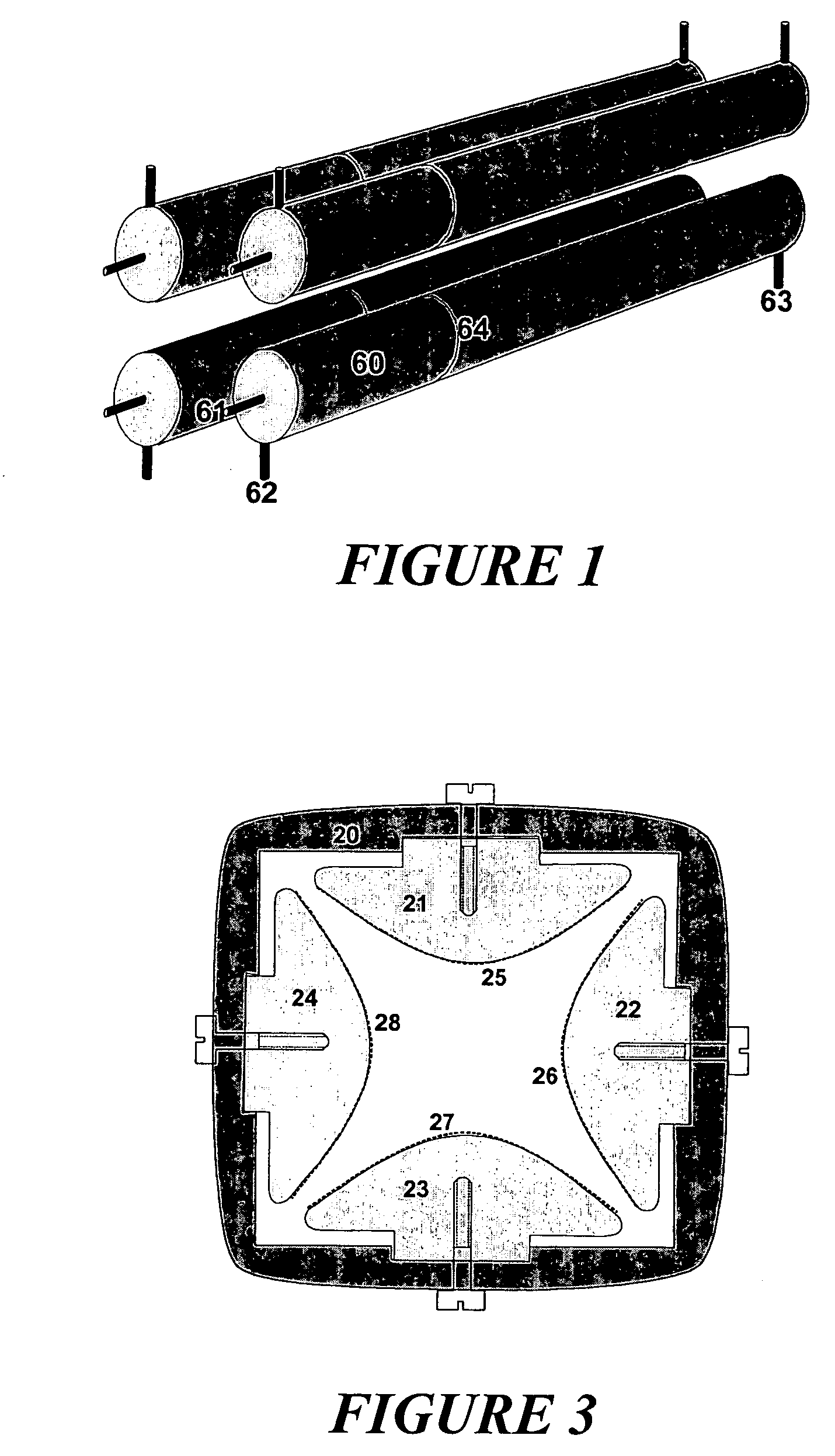RF quadrupole systems with potential gradients
a potential gradient and quadrupole technology, applied in the field of two-dimensional quadrupole systems, can solve the problems of difficult to generate a desired dc electric field along the axis, unable to propagate the rf voltage at the end along the wires sufficiently quickly, and unable to generate a small dc voltage drop along the wires, so as to increase the ion acceptance
- Summary
- Abstract
- Description
- Claims
- Application Information
AI Technical Summary
Benefits of technology
Problems solved by technology
Method used
Image
Examples
first embodiment
[0028]A first embodiment as shown in FIG. 1 consists of a round-rod quadrupole system whose rods (60) are coated with a thin layer of metal over a thin insulating layer. The thin layers of metal are connected via the schematically represented connectors (62, 63) with DC potentials on which, according to the invention, the same phase of the RF voltage is superimposed. The lengthy bulk electrodes themselves are connected via the connectors (61) to a DC potential superimposed with the two phases of the RF voltage. Opposing pairs of the electrodes and their thin metal layers each carry DC voltages superimposed by the same phase of the RF voltage. At the location (64), the thin metal layers are connected to the round-rod electrodes beneath; the DC potential of the round rods therefore lies across the thin metal layers. It is therefore possible to produce different field gradients on either side of these through-hole connections (64).
second embodiment
[0029]A second embodiment as shown in FIG. 2 presents a precision quadrupole mass filter comprising a glass body (1) with four hyperbolic electrode sheets (2, 3) fused on using a hot molding process. A quadrupole mass filter of this type can be produced in accordance with patent specification DE 2737903 (U.S. Pat. No. 4,213,557). It is extraordinarily precise at maintaining all dimensions. The hyperbolic electrode sheets (2, 3) are coated with a layer of a varnish with good insulating properties, for example a polyimide varnish, only a few micrometers thick. When dry, a very thin layer of metal, e.g., chromium or tungsten, only a few nanometers thick can be vapor deposited onto the insulating layer in a vacuum. It is thus possible to produce reproducibly a layer with a resistance of five kilohms, in other cases also with 50 kilohms. The ends of these layers are bonded by means of an electrically conductive varnish to connectors, as shown in FIG. 1.
[0030]The vapor-deposited thin laye...
third embodiment
[0033]A third embodiment is shown in FIG. 3. Here, individual hyperbolic electrodes (21, 22, 23, 24) are made of aluminum and then strongly anodized to generate an oxide layer. The thin metal layers (25, 26, 27, 28) are then vapor deposited onto the oxide layer of the hyperbolic surface. The electrodes are equipped with threads and screwed into an insulating holder (20), which can be a precisely formed glass body produced in a hot-replica technique.
[0034]As those skilled in the art will recognize, the lengthy electrodes of the quadrupole systems can also be made of other electrode materials, which then can be coated with an insulating oxide layer and, of course, it is also possible to use an insulating varnish or any other type of insulating coating here. It is also possible to use other types of insulating frames such as ground ceramic rings to hold the electrodes. Those skilled in the art will also be aware that, for precision quadrupole systems, special measures such as repeated ...
PUM
 Login to View More
Login to View More Abstract
Description
Claims
Application Information
 Login to View More
Login to View More - R&D
- Intellectual Property
- Life Sciences
- Materials
- Tech Scout
- Unparalleled Data Quality
- Higher Quality Content
- 60% Fewer Hallucinations
Browse by: Latest US Patents, China's latest patents, Technical Efficacy Thesaurus, Application Domain, Technology Topic, Popular Technical Reports.
© 2025 PatSnap. All rights reserved.Legal|Privacy policy|Modern Slavery Act Transparency Statement|Sitemap|About US| Contact US: help@patsnap.com



